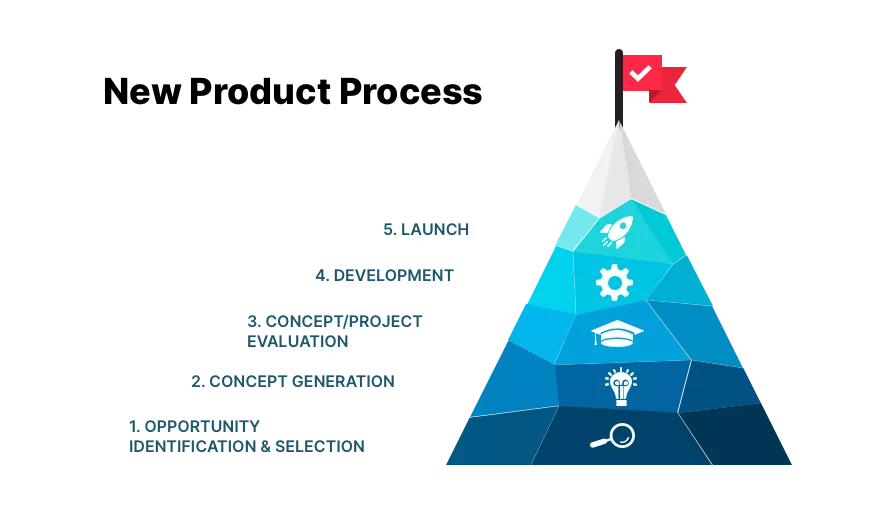The new products process is the path that a new product takes from idea to the time of launch and beyond. Let’s investigate the necessary steps to develop new products: the 5 phases of the new products process.
The 5 phases of the new products process ensure that companies reach maximum efficiency in developing new, successful products. Nothing is worse than wasting substantial financial resources for developing products that the market does not want, only because one of the 5 phases of the new products process was skipped. Certainly, depending on the specific situation, you should handle the process flexibly. For instance, overlapping the phases of the new product process is possible.
However, each of them is of high importance: New product development consumes huge amounts of financial resources. Therefore, it is crucial to rely on a clear step-by-step process to develop new products. Consequently, the amount of risk and uncertainty can be managed.
Between the phases of the new products process are evaluation stages. At these decision points, hard Go or No Go decisions are taken. This makes the significance of the 5 phases of the new products process clear, but also the difficulty: it is a tough task to decide whether a concept or opportunity is worth pursuing. Sunk cost, that is, investment that has already been put into the concept, generates pressure.
Third-Generation New Products Process
As taking hard Go and No Go decisions can be particularly burdensome between the phases of the new products process, so-called “On decisions” can be taken. This is part of the “Third-Generation New Products Process”. This flexible process allows overlapping the 5 phases of the new products process and a conditional Go, in order to prevent slowing down the process. Especially if some key information is still lacking, an On decision allows the new products process to go on while the necessary information to resolve the “fuzzy gate” is collected. The flexibility gained through the third-generation new products process is particularly important in the development of new-to-the-world products (categories of new products).
The Phases of the New Products Process

1. Opportunity Identification and Selection
The first one of the 5 phases of the new products process creates the basis for the development of a successful product. At this stage, an active and passive generation of new product opportunities takes place. For instance, new product suggestions, changes in the marketing plan, resource changes, or new needs and wants in the marketplace may be sources of promising opportunities.
Research, evaluate, validate, and rank the identified opportunities. However, bear in mind that we are still talking about opportunities, not specific product concepts or ideas.
2. Concept Generation
In this stage, a high-potential or urgent opportunity is selected. Also, customer involvement begins. Make sure to understand how the customer wants the existing problem to be solved. Based on that, you can collect available new product concepts that fit the opportunity and generate new concepts as well.
3. Concept/Project Evaluation
Evaluate new product concepts from Stage 2 on technical, marketing, and financial criteria.
Based on the evaluation outcome, the concepts can be ranked and the best two or three ones can be selected.
4. Development
In phase 4, the development of the product, and everything that goes with it, begins. This includes for instance the designing of prototypes, testing and validation of prototypes against protocol, and the designing of the production process for the best prototype. For product and market testing, production can slowly be scaled up.
The development phase combines both technical and marketing tasks. While technical tasks include the designing of prototypes and the production process, marketing tasks involve product strategy, tactics, marketing plan, augmented product, and so on.
The development phase involves serious investments. Therefore, careful considerations at all earlier decision points during the phases of the new product process are crucial.
5. Launch
In the final phase of the process, the product is commercialized.
In other words, you will launch the plans and prototypes from the development phase. This means the beginning of distribution and sale of the new product, which may be on a limited basis at the beginning. Carefully manage your product launch program to achieve the goals and objectives set at the beginning of the new product process and in the business plan.




